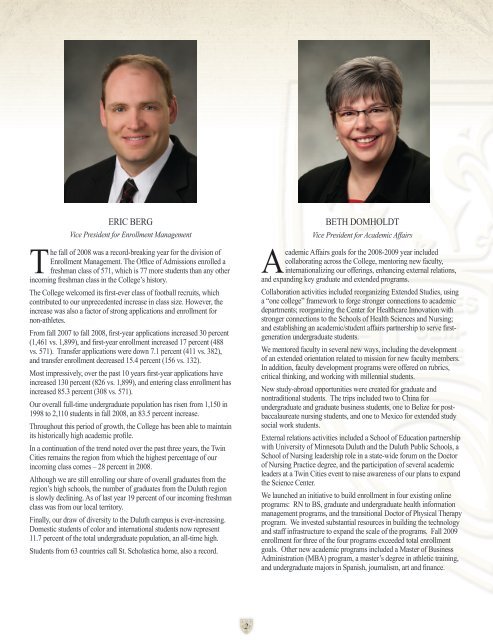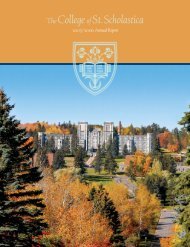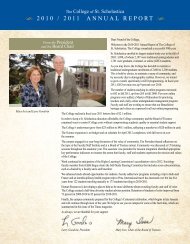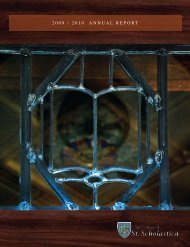This annual giving section recognizes - The College of St. Scholastica
This annual giving section recognizes - The College of St. Scholastica
This annual giving section recognizes - The College of St. Scholastica
Create successful ePaper yourself
Turn your PDF publications into a flip-book with our unique Google optimized e-Paper software.
ERIC BERG<br />
Vice President for Enrollment Management<br />
<strong>The</strong> fall <strong>of</strong> 2008 was a record-breaking year for the division <strong>of</strong><br />
Enrollment Management. <strong>The</strong> Office <strong>of</strong> Admissions enrolled a<br />
freshman class <strong>of</strong> 571, which is 77 more students than any other<br />
incoming freshman class in the <strong>College</strong>’s history.<br />
<strong>The</strong> <strong>College</strong> welcomed its first-ever class <strong>of</strong> football recruits, which<br />
contributed to our unprecedented increase in class size. However, the<br />
increase was also a factor <strong>of</strong> strong applications and enrollment for<br />
non-athletes.<br />
From fall 2007 to fall 2008, first-year applications increased 30 percent<br />
(1,461 vs. 1,899), and first-year enrollment increased 17 percent (488<br />
vs. 571). Transfer applications were down 7.1 percent (411 vs. 382),<br />
and transfer enrollment decreased 15.4 percent (156 vs. 132).<br />
Most impressively, over the past 10 years first-year applications have<br />
increased 130 percent (826 vs. 1,899), and entering class enrollment has<br />
increased 85.3 percent (308 vs. 571).<br />
Our overall full-time undergraduate population has risen from 1,150 in<br />
1998 to 2,110 students in fall 2008, an 83.5 percent increase.<br />
Throughout this period <strong>of</strong> growth, the <strong>College</strong> has been able to maintain<br />
its historically high academic pr<strong>of</strong>ile.<br />
In a continuation <strong>of</strong> the trend noted over the past three years, the Twin<br />
Cities remains the region from which the highest percentage <strong>of</strong> our<br />
incoming class comes – 28 percent in 2008.<br />
Although we are still enrolling our share <strong>of</strong> overall graduates from the<br />
region’s high schools, the number <strong>of</strong> graduates from the Duluth region<br />
is slowly declining. As <strong>of</strong> last year 19 percent <strong>of</strong> our incoming freshman<br />
class was from our local territory.<br />
Finally, our draw <strong>of</strong> diversity to the Duluth campus is ever-increasing.<br />
Domestic students <strong>of</strong> color and international students now represent<br />
11.7 percent <strong>of</strong> the total undergraduate population, an all-time high.<br />
<strong>St</strong>udents from 63 countries call <strong>St</strong>. <strong>Scholastica</strong> home, also a record.<br />
2<br />
BETH DOMHOLDT<br />
Vice President for Academic Affairs<br />
Academic Affairs goals for the 2008-2009 year included<br />
collaborating across the <strong>College</strong>, mentoring new faculty,<br />
internationalizing our <strong>of</strong>ferings, enhancing external relations,<br />
and expanding key graduate and extended programs.<br />
Collaboration activities included reorganizing Extended <strong>St</strong>udies, using<br />
a “one college” framework to forge stronger connections to academic<br />
departments; reorganizing the Center for Healthcare Innovation with<br />
stronger connections to the Schools <strong>of</strong> Health Sciences and Nursing;<br />
and establishing an academic/student affairs partnership to serve firstgeneration<br />
undergraduate students.<br />
We mentored faculty in several new ways, including the development<br />
<strong>of</strong> an extended orientation related to mission for new faculty members.<br />
In addition, faculty development programs were <strong>of</strong>fered on rubrics,<br />
critical thinking, and working with millennial students.<br />
New study-abroad opportunities were created for graduate and<br />
nontraditional students. <strong>The</strong> trips included two to China for<br />
undergraduate and graduate business students, one to Belize for postbaccalaureate<br />
nursing students, and one to Mexico for extended study<br />
social work students.<br />
External relations activities included a School <strong>of</strong> Education partnership<br />
with University <strong>of</strong> Minnesota Duluth and the Duluth Public Schools, a<br />
School <strong>of</strong> Nursing leadership role in a state-wide forum on the Doctor<br />
<strong>of</strong> Nursing Practice degree, and the participation <strong>of</strong> several academic<br />
leaders at a Twin Cities event to raise awareness <strong>of</strong> our plans to expand<br />
the Science Center.<br />
We launched an initiative to build enrollment in four existing online<br />
programs: RN to BS, graduate and undergraduate health information<br />
management programs, and the transitional Doctor <strong>of</strong> Physical <strong>The</strong>rapy<br />
program. We invested substantial resources in building the technology<br />
and staff infrastructure to expand the scale <strong>of</strong> the programs. Fall 2009<br />
enrollment for three <strong>of</strong> the four programs exceeded total enrollment<br />
goals. Other new academic programs included a Master <strong>of</strong> Business<br />
Administration (MBA) program, a master’s degree in athletic training,<br />
and undergraduate majors in Spanish, journalism, art and finance.








